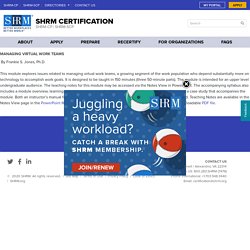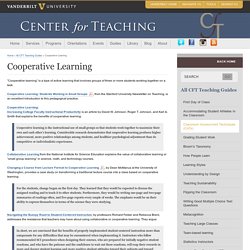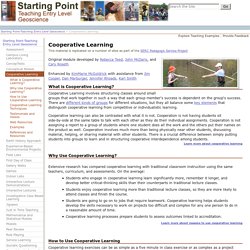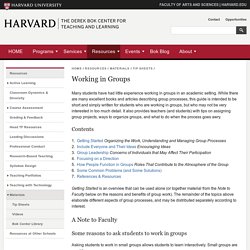

MANAGING VIRTUAL WORK TEAMS. Page Content By Frankie S.

Jones, Ph.D. This module explores issues related to managing virtual work teams, a growing segment of the work population who depend substantially more on technology to accomplish work goals. It is designed to be taught in 150 minutes (three 50-minute parts). The module is intended for an upper level undergraduate audience. Page Content By Frankie S. This module explores issues related to managing virtual work teams, a growing segment of the work population who depend substantially more on technology to accomplish work goals.
ManagingVirtualWorkTeamsSyllabus. Student Engagement, Retention & Success. Plays: Find the right Plays for your team. Groupselfassessmenttool. Guidelines for student presentations in class. CTE - Collaborative Learning. Cooperative Learning. Home » All CFT Teaching Guides » Cooperative Learning “Cooperative learning” is a type of active learning that involves groups of three or more students working together on a task.

Cooperative Learning: Students Working in Small Groups, from the Stanford University Newsletter on Teaching, is an excellent introduction to this pedagogical practice. Cooperative Learning: Increasing College Faculty Instructional Productivity is an article by David W. Johnson, Roger T. Johnson, and Karl A. Cooperative Learning. Original module developed by Rebecca Teed, John McDaris, and Cary Roseth Enhanced by KimMarie McGoldrick with assistance from Jim Cooper, Dan Marburger, Jennifer Rhoads, Karl Smith What is Cooperative Learning?

Cooperative Learning involves structuring classes around small groups that work together in such a way that each group member's success is dependent on the group's success. There are different kinds of groups for different situations, but they all balance some key elements that distinguish cooperative learning from competitive or individualistic learning. Group work: Using cooperative learning groups effectively. Derek Bok Center for Teaching and Learning. Many students have had little experience working in groups in an academic setting.

While there are many excellent books and articles describing group processes, this guide is intended to be short and simply written for students who are working in groups, but who may not be very interested in too much detail. It also provides teachers (and students) with tips on assigning group projects, ways to organize groups, and what to do when the process goes awry. Contents Getting Started is an overview that can be used alone (or together material from the Note to Faculty below on the reasons and benefits of group work). The remainder of the topics above elaborate different aspects of group processes, and may be distributed separately according to interest.
Creating a charter for your team! - Wisdom Café. Starting on a new team can be exciting and energizing, especially when you’re motivated by the team’s mission and inspired by the people you’ll be working with.

But it can also be nerve-racking not knowing how you’ll actually work together as a team. Infographic group tips 2015. Four Types of Group Work Activities to Engage Students. Collaboration helps to develop many of the key skills that will be required of students for their future success.

Students can develop many of these so-called “soft skills,” or Essential Employability Skills, by engaging in group work and other forms of collaboration (Ontario Ministry of Advanced Education and Skills Development 2005). Collaboration leads to greater retention, improved student achievement, and increased self-esteem and metacognition, and it can be used to facilitate active learning and to promote inclusion by increasing contact among diverse groups (Bossert 1988; Bowman, Frame, and Kennette 2013; Hennessey 1999; Kennette and Frank 2010; Kramarski and Mevarech 2003; Rajaram and Pereira-Pasarin 2007; U.S.
Department of Education 1992). Despite the many benefits of group work, instructors are sometimes hesitant to use it due to some of its well-known pitfalls (social loafing, disputes, individualized grading, student bemoaning, etc.). References Bossert, S. Cortright, R. 5 Online Group Collaboration Ideas For Your Next eLearning Course. Student Collaboration in the Online Classroom. Sample assignment1. Sample assignment2. Sample assignment3. Surviving GROUP PROJECTS. Quick Team Assessment. How to Manage Group Projects. I.

Getting Started To ensure that your group gets off to a good start, it may be beneficial to: Take time for all members to introduce themselves, including name, background, and stating specific strengths in contributing to the overall goals of the assignment. Nominate or vote to have someone act as the group leader or facilitator or scheduler. If the burdon might be too great, comsider deciding to rotate this responsibility among all group members.
II. After you and the other members of the group agree about how to approach the assignment, take time to make sure everyone understands what it is they will need to achieve. What are the goals of the assignment? III. This is the stage when your group should plan exactly what needs to be done, how it needs to be done, and who should do what. Work together to break the project up into separate tasks and decide on the tasks or sub-tasks each member is responsible for. IV. Keep in touch with each other frequently, reporting progress regularly. Cooperative learning group activites. Assessing Online Team Based Learning. Assessing Group Work. 7 problems with group work. Sample Peer Eval Forms. Peer Eval System. BaabLGroupWorkReflectionAssignment. BaabLGroupWorkPeerAssessment. BaabLGradingSelfAnalysisofGroupContribution.
BaabLGradingPresentationofGroupExperience.